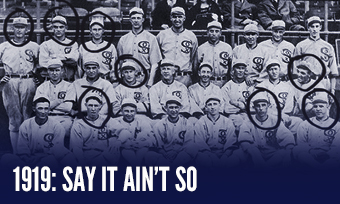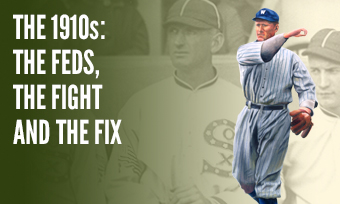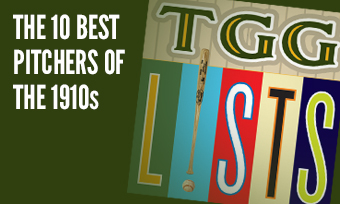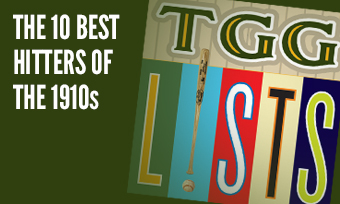The Yearly Reader
Leaders and Honors, 1919
Our list of baseball’s top 10 hitters and pitchers in both the American League and National League for the 1919 baseball season, as well as the awards and honors given to the game’s top achievers of the year.
The National League’s Top 10 Hitters, 1919
Bold type in brick red indicates league leader.
1. Edd Roush, Cincinnati
Key Numbers: .321 average, 19 doubles, 12 triples, 71 RBIs.
Roush’s average may have been the NL’s best, but it was his personal worst between 1917-26.
2. Heinie Groh, Cincinnati
Key Numbers: .310 average, 79 runs, 17 doubles, 11 triples, 56 walks.
Roush’s prime equal in the Reds lineup was in the top five of most NL offensive categories—but he failed to place first in any of them.
3. George Burns, New York
Key Numbers: .303 average, 86 runs, 30 doubles, 9 triples, 82 walks, 40 stolen bases, .396 on-base percentage.
Burns used more than his bat to rankle pitchers, leading the NL in walks and steals.
4. Rogers Hornsby, St. Louis
Key Numbers: .318 average, 163 hits, 9 triples, 8 home runs, 71 RBIs.
The Rajah collected nearly half of the Cardinals’ total home run output (18).
5. Benny Kauff, New York
Key Numbers: .277 average, 27 doubles, 7 triples, 10 home runs, 67 RBIs.
The last rodeo at the top for the former Federal League star; within a year he’d be dogged by auto theft charges and his involvement in the Black Sox Scandal.
6. Hi Myers, Brooklyn
Key Numbers: .307 average, 23 doubles, 14 triples, 73 RBIs, .436 slugging percentage.
Myers’ RBI total and slugging percentage were both the lowest ever by a modern-day NL leader.
7. Ross Youngs, New York
Key Numbers: .311 average, 31 doubles, 7 triples.
The compact, aggressive and quiet Youngs—a favorite pet of John McGraw—began to make an impact for the Giants at age 22.
8. Larry Doyle, New York
Key Numbers: 113 games, .289 average, 10 triples, 7 home runs, 52 RBIs, 12 stolen bases.
In his penultimate season, the 33-year-old Giants captain gave a solid renaissance after a couple of relatively mediocre seasons.
9. Zack Wheat, Brooklyn
Key Numbers: .297 average, 23 doubles, 11 triples, 5 home runs, 62 RBIs, 15 stolen bases.
At age 31, Wheat was given the captainship of the Robins and responded with one of his more productive Deadball Era campaigns; the coming live ball would catapult his statistical game even more.
10. Billy Southworth, Pittsburgh
Key Numbers: .280 average, 14 doubles, 14 triples, 61 RBIs, 23 stolen bases.
The young outfielder made for a solid everyday debut, in advance of a managerial career that would land him in the Hall of Fame.
The American League’s Top 10 Hitters, 1919
1. Babe Ruth, Boston
Key Numbers: .322 average, 103 runs, 34 doubles, 12 triples, 29 home runs, 113 RBIs, 101 walks, .456 on-base percentage, .657 slugging percentage.
The Bambino gave the Red Sox a fleeting taste of what they were going to miss over the next 15 years.
2. Bobby Veach, Detroit
Key Numbers: .355 average, 87 runs, 191 hits, 45 doubles, 17 triples, 3 home runs, 101 RBIs.
Banner year for the star outfielder with career highs in batting average, hits, doubles and triples.
3. George Sisler, St. Louis
Key Numbers: .352 average, 96 runs, 180 hits, 31 doubles, 15 triples, 10 home runs, 83 RBIs, 28 stolen bases.
Sisler hit at least .340 for the third straight year to round out the Deadball Era; that would be nothing compared to what he had in store for the next three seasons.
4. Ty Cobb, Detroit
Key Numbers: .384 average, 92 runs, 191 hits, 36 doubles, 13 triples, 28 stolen bases.
The Georgia Peach won the last of his 12 batting crowns, but his best years were hardly behind him.
5. Joe Jackson, Chicago
Key Numbers: .351 average, 181 hits, 31 doubles, 14 triples, 7 home runs, 96 RBIs.
Shoeless Joe returned to early-career form by hitting on the north side of .350, but it was mere prologue to the fateful events of the ensuing World Series.
6. Eddie Collins, Chicago
Key Numbers: .319 average, 87 runs, 4 home runs, 80 RBIs, 68 walks, 33 stolen bases.
Unlike Jackson, Collins was not part of the Black Sox cabal but he too had one of his stronger years in recent times.
7. Harry Heilmann, Detroit
Key Numbers: .320 average, 74 runs, 30 doubles, 15 triples, 8 home runs, 93 RBIs.
The Tigers skipped nary a beat with the loss of retired Sam Crawford, as the equally talented Heilmann took over.
8. Tris Speaker, Cleveland
Key Numbers: .296 average, 83 runs, 38 doubles, 12 triples, 73 walks.
Perhaps adjusting to a mid-season inheriting of the Indians’ manager position, Speaker batted below .300 for the only time outside of his first and last years.
9. Sam Rice, Washington
Key Numbers: 141 games, .321 average, 179 hits, 23 doubles, 9 triples, 26 stolen bases.
After serving the military in 1918—ultimately costing him a shot at 3,000 hits—Rice returned to Washington and resumed his early stellar form.
10. Elmer Smith, Cleveland
Key Numbers: 114 games, .278 average, 24 doubles, 9 home runs, 54 RBIs, 15 stolen bases.
After failing to crack Washington’s starting lineup and spending all of 1918 in France as an Army sergeant, Smith arrived in Cleveland and became the team’s prime power source; no teammate hit more than three homers.
The National League’s Top 10 Pitchers, 1919
1. Babe Adams, Pittsburgh
Key Numbers: 1.98 ERA, 17 wins, 10 losses, 263.1 innings, 23 walks.
All but forgotten after a two-year absence, Adams marveled anew at age 37—and for the first of three straight years would be the NL’s toughest pitcher to reach base against.
2. Hippo Vaughn, Chicago
Key Numbers: 1.79 ERA, 21 wins, 14 losses, 37 starts, 306.2 innings, 141 strikeouts.
Vaughn retained his standing as NL workhorse; if not again for a shortened (140 games) schedule, his innings total would have been all the more impressive.
3. Slim Sallee, Cincinnati
Key Numbers: 2.06 ERA, 21 wins 7 losses.
So homesick that he refused to return to the Giants, Sallee was granted a trade closer to his Ohio home with the Reds and responded with his best effort at age 34.
4. Pete Alexander, Chicago
Key Numbers: 1.72 ERA, 16 wins, 11 losses, 9 shutouts.
Though his traumatizing front-line duty during the Great War may have changed the great ace off the mound, it didn’t seem to affect him while he was on it as he grabbed his third ERA crown.
5. Jesse Barnes, New York
Key Numbers: 2.40 ERA, 25 wins, 9 losses, 295.2 innings.
The Giants beat the Yankees and Red Sox to the punch in initiating a one-sided Boston-to-New York pipeline, as former Braves pitcher and 25-game winner Barnes proved.
6. Ray Fisher, Cincinnati
Key Numbers: 2.17 ERA, 14 wins, 5 losses, .737 win percentage, 174.1 innings.
Arriving in Cincinnati after a full year of military duty, the veteran who spent much of the 1910s with the Yankees started slowly but was excellent down the stretch, going 6-0 with a 0.77 ERA from mid-July on.
7. Wilbur Cooper, Pittsburgh
Key Numbers: 2.67 ERA, 19 wins, 13 losses, 27 complete games, 286.2 innings, 15 hit-by-pitches.
Cooper settled for 19 wins for the second straight year after losing each of his last three starts; he made sure that would never happen again.
8. Hod Eller, Cincinnati
Key Numbers: 2.39 ERA, 19 wins, 9 losses, 248.1 innings.
Eller’s career peaked because the rules made him; the shineballer would not be given the same “grandfather” leniency as spitball artists starting in 1920.
9. Jimmy Ring, Cincinnati
Key Numbers: 2.26 ERA, 10 wins, 9 losses, 32 appearances, 18 starts, 12 complete games, 183 innings.
His wild days still ahead of him—he would lead the NL four times in both walks and wild pitches during the 1920s—Ring showed a more controlled side to his career.
10. Fred Toney, New York
Key Numbers: 1.84 ERA, 13 wins, 6 losses, 24 appearances, 181 innings.
A four-month jail sentence for dodging the World War I draft kept Toney out of action until the end of May—then he pitched better than ever.
The American League’s Top 10 Pitchers, 1919
1. Eddie Cicotte, Chicago
Key Numbers: 1.82 ERA, 29 wins, 7 losses, 30 complete games, .806 win percentage, 306.2 innings.
Fixing the World Series notwithstanding, Cicotte’s emotions were yo-yo-ing enough, leading the AL in wins one year (1917), in losses the next (1918) and in wins again during 1919.
2. Walter Johnson, Washington
Key Numbers: 1.49 ERA, 20 wins, 14 losses, 7 shutouts, 290.1 innings, 147 strikeouts.
The Decade of Walter concluded with the Big Train winning his fourth ERA title, his ninth strikeout crown (and eighth in succession), and with a win in his final start ensured that he would win 20 or more games every year during the 1910s.
3. Stan Coveleski, Cleveland
Key Numbers: 2.61 ERA, 24 wins, 12 losses, 286 innings.
The Cleveland ace consistently carried on, racking up another 20-plus wins.
4. Bob Shawkey, New York
Key Numbers: 2.72 ERA, 20 wins, 11 losses, 5 saves, 261.1 innings.
The veteran pitcher who experienced the best and worst of times earlier in the decade with the A’s was enjoying high times in New York; he was particularly good at the Polo Grounds (the Yankees’ home until 1923), where he posted a 12-1 record.
5. Carl Mays, Boston-New York
Key Numbers: 2.10 ERA, 14 wins, 14 losses, 266 innings.
Despite his house burning down, run-ins with fans and a demand for a trade from Boston—which he got—Mays managed to stay focused on the mound.
6. Carl Weilman, St. Louis
Key Numbers: 2.07 ERA, 10 wins, 6 losses.
A rare, if limited, winning year for the veteran lefty who struggled for support earlier in the decade.
7. Lefty Williams, Chicago
Key Numbers: 2.64 ERA, 23 wins, 11 losses, 40 starts, 297 innings, 11 hit-by-pitches.
The first of two consecutive 20-win campaigns for the young southpaw; there may have been more such results in his future—but because of the Black Sox Scandal, we’ll never know.
8. Jack Quinn, New York
Key Numbers: 2.61 ERA, 15 wins, 14 losses, 266 innings.
Back in New York City after seven years wandering about elsewhere, Quinn put together a solid effort at age 36; little did anyone realize that he’d be sticking around for quite a while.
9. Jim Shaw, Washington
Key Numbers: 2.73 ERA, 17 wins, 17 losses, 5 saves, 45 appearances, 306.2 innings, 10 wild pitches.
Walter Johnson may have remained the Washington ace, but Shaw could officially claim the title of team workhorse—becoming the first Senator besides Johnson to lead the team in innings pitched since 1908.
10. Allen Sothoron, St. Louis
Key Numbers: 2.20 ERA, 20 wins, 13 losses, 270 innings.
Sothoron, who like Eddie Cicotte once led the AL with 19 losses (in 1917), also enjoyed his finest year; he couldn’t maintain his excellence going forward even as he was allowed to continue throwing the spitter after 1920.









